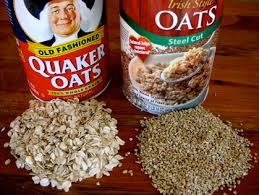What is a whole grain? A whole grain is exactly what it says it is whole. It is not part of the grain, but it is grain in its entirety.
- There are 3 main parts of a grain.
-
- Bran - responsible for fiber, contains phosphorus (aids in absorption of Calcium into bones), protein (can't begin to tell all of the wonderful benefits of proteins), and thiamine (vitamin B1)
- Germ - most concentrated source of nutrients, including fat, B vitamins, and iron
- Endosperm - starch (sugar chains) and protein (to make gluten!)
- You can buy all three parts separately.
- Bran: in a container that says bran, it will add fiber to what you are making
- Germ: also bought in a container, can spoil because contains fat
- Endosperm: what you know as flour.
- What is flour?
- Flour is a refined product of the grain. It is where the bran and germ are stripped from the endosperm to create a high glutenous product that serves very well in baking. It is often enriched, meaning they fortify it with iron, B vitamins, and folic acid.
- Why do I need a whole grain if it is fortified?
- Well, to put it simply you do not absorb fortified items the same way you do as when they are in their natural environment.
- Here's a parallel, follow me with this. It is like tanning. You can A. tan outside with the natural sun, B. tan in a tanning bed, or C. spray on your tan. However, you might look tan with all 3, but you will not benefit from producing Vitamin D from the latter 2. So, nature always provides the best method.
- How many whole grains should I eat a day?
- You should eat 6 ounces of whole grains every day. Your body will greatly benefit from all of the nutrients and even the sugars. As, this complex carbohydrate serves as brain food.
- What are some good examples of whole grains I can eat?
- Whole wheat anything
- Brown rice
- Barley
- Buckwheat
- Corn
- Amaranth (never heard of it, but read about it, GOING TO TRY IT)
- Bulgur
- Oatmeal, rolled or steel cut*.
- Quinoa*
- BY THE WAY Multi-grain does not mean whole grain, it means the product was made from multiple types of grain... corn plus wheat plus rice etc.
| So many different types of whole grains! |
*Steel Cut Oats -- these are oats that are cut and not rolled. Rolled oats are flattened to increase cooking time, steel cut are just cut. They can aid in making you feel fuller longer, but they do take about 20-30 minutes to cook. They also are not nutritionally better than rolled, just fill better.
*Quinoa: Ancient Peruvian Secret (As the article I read called it)
 |
| Buy yours today! |
Quinoa contains a super high amount of proteins. It contains almost if not all essential amino acids needed by your body. It only takes about 10 minutes to cook, and can be used in all types of preparations. Whether you want to eat it in the morning like oatmeal with milk and sugar (this is how I first ate it in Peru) or you can throw it with vegetables. You can eat it hot like a pasta or cold in salad form. This grain is highly nutritive and beneficial to your body. If you haven't tried it you should, and if you don't like it the first time don't give up. Because it grew on me.
| Quinoa Plant |
This was In the Pantry: Whole Grains. Stay tuned to find out more of what should be in your pantry!
No comments:
Post a Comment